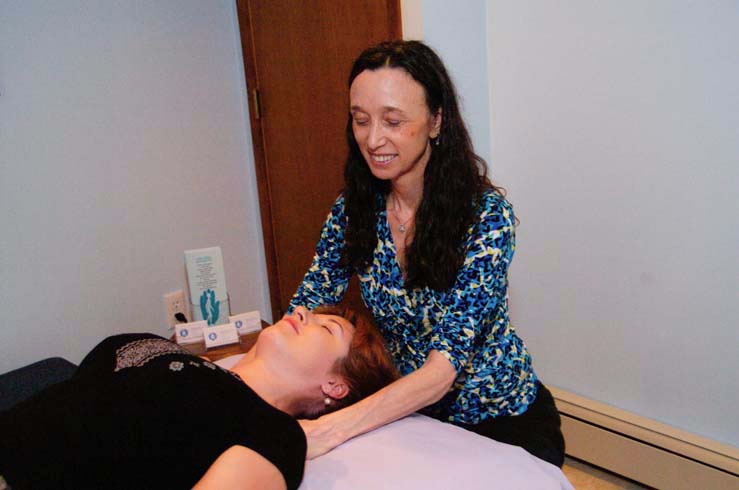
Many people arrive for their first Rolfing session with apprehension. New clients wonder if Rolfing can help them to overcome a particular problem. Often, people wonder how Rolfing will feel.
Here’s what you can expect to happen during your first Rolfing session.
We begin by sitting down together. We are curious to know where you have been, how you are currently, and what you would like to happen in your future. Your health history, the physical, emotional challenges you are facing are of interest to us. We want to know what brings you to Rolfing, and what you would like to receive from the process.
A visual assessment is next.
While you stand with your feet together we will take note of how your structure is organized. Each person has a unique way of holding themselves together to cope with their life experience, and accomplish all they need to do. We are looking to see how your body lines up within the gravity field. How your body parts relate to the vertical axis in front of your spine has bearing upon the stresses and strains that you experience on a daily basis. We will note whether your head sits directly over the shoulders, whether your shoulders are over your hips, as well as the hips and knees over the ankles.
We will also observe your postural and movement patterns as you sit, how you transition into standing and walking. Your gait pattern is of particular interest to us, as every time your feet touch ground the effects resonate upwards through your spine.
When appropriate we record range of motion, strength, functional deficits and other findings as part of a Physical Therapy evaluation. Our assessment involves viewing the body from many different perspectives and provides us with valuable information pertaining to how the Rolfing can enhance you with a more easeful well functioning physical body.
Traditional Rolfers perform the basic ten session Rolfing series on all who are new to Rolfing. This allows the Rolfer to work through the whole structure progressively. While each client’s ten series is unique, we have some predetermined, specific goals for each session. For example, in the first session, we are looking for openness and freedom in the shoulder, anterior chest, lateral and posterior hips, back and neck.
 Rolfers apply sustained pressure through their hands to open up chronic holding patterns in the connective tissue wrappings surrounding each muscle. You might feel warmth, tingling and sometimes momentary discomfort from the work. Most report a sense of vitality or openness in their body that is new and exciting, as they feel increased energy circulating, breath and movement returning. You are in control of the comfort dial. We request that anytime you feel the sensation is too strong that you make it known.
Rolfers apply sustained pressure through their hands to open up chronic holding patterns in the connective tissue wrappings surrounding each muscle. You might feel warmth, tingling and sometimes momentary discomfort from the work. Most report a sense of vitality or openness in their body that is new and exciting, as they feel increased energy circulating, breath and movement returning. You are in control of the comfort dial. We request that anytime you feel the sensation is too strong that you make it known.
We are experts at modulating our pressure and approaching the resistant tissue from different angles. If you are relaxed and comfortable enough, then the door opens for you to let go of your tension and habitual patterns of bracing. The quote “No pain no gain” does not apply with Rolfing. While we bring a depth of training and experience, it’s you who are in charge of how much sensation is enough for you. “No pain no gain” is a primitive approach to working on a sensitive and intelligent body. Instead we seek to tease out stuck patterns and nudge the body towards integrated and free movement.
Rolfing is designed to improve your posture, alignment and mobility.
 Rolfers work on specific problems within the context of the whole structure. Your reasons for receiving Rolfing are a priority to us, however the way that we address those issues might sometimes seem mysterious. For example, the alignment of your feet has everything to do with your back and how it’s working. Rolfers see a direct relationship between how your calcaneus (heel bone) is aligned and moving with how the sacrum is functioning. As the mechanics of the foot and ankle improve, the upper back straightens.
Rolfers work on specific problems within the context of the whole structure. Your reasons for receiving Rolfing are a priority to us, however the way that we address those issues might sometimes seem mysterious. For example, the alignment of your feet has everything to do with your back and how it’s working. Rolfers see a direct relationship between how your calcaneus (heel bone) is aligned and moving with how the sacrum is functioning. As the mechanics of the foot and ankle improve, the upper back straightens.
Most people feel immediate change for the better by the end of a treatment.
They often express feeling lighter and more stable after the first session. They also find that their rib cage expands and releases further allowing for easier breathing.
Rolfing is best suited to treat chronic problems and also to facilitate personal growth. The process of ten sessions allows us to get at the underpinnings of longstanding issues. There are very few contraindications for Rolfing. We have treated a population that encompasses infancy through old age as well as healthy and chronically ill. All that is really required is openness to the possibilities and receptivity that accompany letting go of the physical baggage that has been helpful in the past but is no longer serving us.
